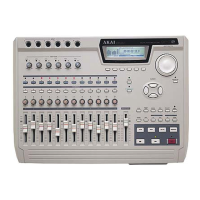
Do you have a question about the Akai DPS12 and is the answer not in the manual?
| Type | Digital Audio Workstation |
|---|---|
| Number of Tracks | 12 |
| Simultaneous Recording Tracks | 8 |
| Simultaneous Playback Tracks | 12 |
| Sampling Rate | 44.1 kHz |
| Bit Depth | 16-bit |
| EQ | 3-band EQ |
| Effects | Reverb, Delay, Chorus |
| MIDI | In/Out |
| Storage | Internal hard drive |
| Display | LCD display |
| A/D Conversion | 16-bit |
| D/A Conversion | 16-bit |
Details the key features of the DPS12, including its recording, mixing, and data storage capabilities.
Illustrates basic connections for recording, including sound sources, monitor systems, and master recorders.
Covers essential preparations before recording, such as powering on, formatting disks, and creating projects.
Explains the MAIN and TRACK VIEW screens used for recording and playback operations.
Provides a step-by-step guide to recording the first track using an example.
Explains the overdubbing process, allowing recording new parts while monitoring existing tracks.
Describes how to use the Undo/Redo functions to cancel or restore previous recording or editing operations.
Covers manual and auto punch in/out operations for re-recording specific track sections.
Explains the mixdown process, including setting levels, panning, and recording to a master recorder.
Details how to use transport buttons, JOG/SHUTTLE dials for playback and locating.
Explains storing, moving to, and deleting locate points for efficient song navigation.
Details manual punch in/out operations using transport buttons or a foot switch.
Explains how to automatically perform punch in/out operations using specified IN/OUT points.
Describes the rehearsal function for practicing punch in/out operations without recording.
Details how to assign various input signals to physical tracks.
Explains how to assign one of the 250 virtual tracks to a physical track.
Introduces Mixer mode for controlling mix parameters like level, pan, EQ, and AUX sends.
Details how to adjust channel and master levels and channel panning (stereo image).
Covers setting EQ parameters like ON/OFF, frequency, level, and band width for channels.
Details settings for AUX send A/B, including mono/stereo modes, levels, and pre/post.
Covers storing, recalling, and erasing scene memories for mix parameter settings.
Details various edit commands like COPY PASTE, CUT INSERT, and their functions.
Details various parameters controllable via the Control Panel for device settings.
Covers backing up Projects to SCSI devices or DAT recorders for data safety.
Details syncing the DPS12 to an external MIDI device using MIDI Time Code (MTC).
Explains syncing the DPS12 to an external device using MIDI Clock and Song Position Pointer.
Lists and describes parameters for various effects like Chorus, Flanger, Phaser, and Delay.